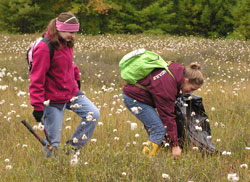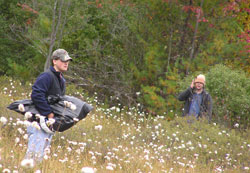|
Biology Club has more on its agenda this year Katie Hite, president of the Biology Club, said the group is busy this semester. Career and graduate school options are on the agenda of the club each week, as members hear from invited faculty who talk to them about research, graduate schools and other professional issues.
|
The Biology Club helped preserve a unique sphagnum bog in Western New York recently by digging up and removing white pines that were re-seeding from a nearby woods and threatening the survival of the rare wetland near Springville, N.Y.
The bog is owned and managed by the Nature Sanctuary Society of Western New York.
The students took many of the smaller tree specimens and planted them on campus in the university's native species garden.
By removing the trees, the Biology Club was preserving the bog's natural flora, including the cottongrass whose late summer seed heads are seen bobbing in the photos at right. Native bog plants at risk from an encroaching white pine population include cranberry, orchids, leatherleaf, bog rosemary, and sphagnum moss, also known as peat moss.
Neighbors call the 24-acre bog near Springville the "Concord Bog," but its real name is Frederick Houghton Preserve. It is one of three properties protected by the Nature Sanctuary Society, which was founded in 1934. The society also owns an old growth forest in Zoar Valley and a fen near Springville.
Woods Hole Research Center description of a Sphagnum Bog
"Sphagnum Bogs are rare wetlands that formed in wet depressions and have thick sphagnum mats and deep peat layers that are permeated by stagnant, acidic and mostly anoxic waters.The dominant plants of these bogs are herbaceous, low shrubs such as cranberry (Vaccinium macrocarpon) and leatherleaf (Chamaedaphne calyculata), as opposed to marshes and swamps, which are dominated by grasses and trees, respectively.
"The water quality inhibits decay, so fallen trees, pollen, or other organic material may remain preserved beneath the surface of the bog for thousands of years. Nutrients are locked up in the undecayed material, so growth conditions in the bog are nutrient-poor, and the bog plants are adapted accordingly."





